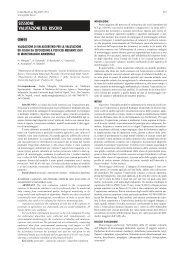03 comunic / libere /1 - Giornale Italiano di Medicina del Lavoro ed ...
03 comunic / libere /1 - Giornale Italiano di Medicina del Lavoro ed ...
03 comunic / libere /1 - Giornale Italiano di Medicina del Lavoro ed ...
You also want an ePaper? Increase the reach of your titles
YUMPU automatically turns print PDFs into web optimized ePapers that Google loves.
COMUNICAZIONI - TEMI LIBERI G Ital M<strong>ed</strong> Lav Erg 20<strong>03</strong>; 25:3 Suppl<br />
216 www.gimle.fsm.it<br />
P. Boccalon 1 , F. Torricelli 2 , P. Zoccarato 2 , R. Taiuti 2 , S. Petrini 2 , E. Magnelli 2 , E. Leprini 2 , R. Giar<strong>di</strong>ello 2 , L. Focar<strong>di</strong> 1<br />
Il part time in un’Azienda Osp<strong>ed</strong>aliera: stu<strong>di</strong>o sui lavoratori atipici<br />
1 UO Me<strong>di</strong>cina Preventiva dei Lavoratori Azienda Osp<strong>ed</strong>aliera Careggi<br />
2 Comitato per le pari opportunità Azienda Osp<strong>ed</strong>aliera Careggi<br />
RIASSUNTO. Il d. lgsl. 626/’94 pone a carico <strong>del</strong> datore <strong>di</strong><br />
lavoro precisi obblighi <strong>di</strong> formazione e informazione nei<br />
confronti dei rappresentanti dei lavoratori e dei lavoratori. Le<br />
norme <strong>di</strong> “buona tecnica” da applicare nel realizzare<br />
interventi formativi sono: progettazione <strong>del</strong>l’intervento in<br />
rapporto ai bisogni formativi dei destinatari, utilizzazione <strong>di</strong><br />
metodologie in<strong>di</strong>rizzate a favorire l’appren<strong>di</strong>mento e<br />
l’adozione <strong>di</strong> comportamenti sicuri, approntamento <strong>di</strong><br />
strumenti valutativi. A tale scopo risultanto utili i contributi<br />
<strong>del</strong>le <strong>di</strong>verse <strong>di</strong>scipline che hanno stu<strong>di</strong>ato la percezione e la<br />
<strong>comunic</strong>azione <strong>del</strong> rischio e l’<strong>ed</strong>ucazione degli adulti. Anche<br />
sulla base <strong>del</strong>le prime esperienze condotte in applicazione <strong>del</strong>la<br />
legge, sono proposti strumenti in<strong>di</strong>rizzati in particolare ai<br />
rappresentanti dei lavoratori, ai membri dei comitati<br />
paritetici, ai consulenti e agli stessi datori <strong>di</strong> lavoro, capaci <strong>di</strong><br />
favorire l’appren<strong>di</strong>mento <strong>di</strong> concetti complessi quali: i mo<strong>del</strong>li<br />
probabilistici <strong>di</strong> causalità, il ruolo dei fattori cognitivi <strong>ed</strong><br />
emotivi <strong>del</strong>l’appren<strong>di</strong>mento, le definizioni <strong>di</strong> agente<br />
cancerogeno elaborate dai <strong>di</strong>versi organismi nazionali <strong>ed</strong><br />
internazionali, il significato dei TLV nel caso <strong>di</strong> esposizione a<br />
cancerogeni, l’interazione tra cancerogeni in caso <strong>di</strong><br />
esposizioni multiple, la valutazione <strong>del</strong> rischio.<br />
Parole chiave: agenti cancerogeni, formazione dei lavoratori.<br />
ABSTRACT. www.gimle.fsm.it<br />
PROTECTION FROM CARCINOGENIC AGENTS THE DUTY OF TRAINING.<br />
Accor<strong>di</strong>ng to act 626/1994, employers have the duty to inform<br />
and train workers and their representatives. The implementation<br />
of training activities requires the following points: planning the<br />
training progra accor<strong>di</strong>ng to the ne<strong>ed</strong>s of the target population,<br />
use of the methods aim<strong>ed</strong> at promoting learning and the<br />
adoption of safe behaviour, setting-up of evaluation tools. The<br />
<strong>di</strong>sciplines of risk perception and communication and adult<br />
training may provide useful contribution in this frame. At the<br />
light of the preliminary experiences in this field, the importance<br />
of the following items for workers, workers representatives and<br />
employers is emphasiz<strong>ed</strong>: probabilistic causality mo<strong>del</strong>s, role of<br />
cognitive and emotional factors in the learning process,<br />
definition of carcinogenic accor<strong>di</strong>ng to national and<br />
internationals organisation, meaning of TLV with respect to<br />
carcinogenic exposure, interaction between carcinogens in the<br />
case of multiple exposition, risk evaluation, preventive measures,<br />
transfer of carcinogen risk from workplace to domestic<br />
environment, due to lack of compliance with basic hygienic rules<br />
such proper use of work clothes.<br />
Key words: carcinogenic agents, worker’s training.<br />
Introduzione<br />
Il lavoro part time, che ha avuto una regolamentazione con i Decreti<br />
Legislativi 61/2000 e 1009/2001, in Italia ha visto un progressivo aumento,<br />
passando dal 6.3% degli occupati nel 1995 all’8.6% <strong>del</strong> 2002 (1).<br />
La popolazione che ricorre al lavoro part time è prevalentemente femminile;<br />
le motivazioni per cui viene richiesto sono legate prevalentemente<br />
alla mancanza <strong>di</strong> lavoro o all’impossibilita <strong>di</strong> svolgere un lavoro full time<br />
per varie motivazioni (2).<br />
Il Comitato per le pari Opportunità <strong>del</strong>l’Azienda Osp<strong>ed</strong>aliera Careggi<br />
(CPO-AOC), al fine <strong>di</strong> stu<strong>di</strong>are l’estensione e le motivazioni <strong>del</strong> ricorso<br />
al part time all’interno <strong>del</strong>l’Azienda, partendo dal presupposto che solo<br />
in casi spora<strong>di</strong>ci si tratti <strong>di</strong> una vera “scelta”, mentre nel maggior parte<br />
dei casi tale decisione sia legata a carenze <strong>di</strong> soluzioni alternative, ha<br />
condotto un’indagine sulle motivazioni che hanno indotto i lavoratori alla<br />
richiesta <strong>del</strong> part time.<br />
Materiali, soggetti e meto<strong>di</strong><br />
Lo strumento utilizzato è stato un questionario anonimo, inviato a<br />
tutti i lavoratori a rapporto <strong>di</strong> lavoro part time. Il questionario analizza<br />
le motivazioni per cui è stata richiesta la trasformazione <strong>del</strong> rapporto<br />
<strong>di</strong> lavoro da full time a part time e le opportunità che, se offerte,<br />
avrebbero evitato il ricorso al part time. Le risposte, raggruppate in<br />
categorie, sono state elaborate me<strong>di</strong>ante test statistici parametrici o<br />
non parametrici.<br />
Il personale a part time all’interno <strong>del</strong>l’AOC alla data <strong>del</strong><br />
10/12/2002 era composto da n. 282 soggetti, pari al 4.99% <strong>del</strong>l’organico<br />
totale. Si tratta <strong>di</strong> personale giovane (età me<strong>di</strong>a part time 39.4 ± 6.2<br />
anni, range 29-62, full time 42.1 ± 9.4 anni, range 22-70; t-student<br />
p

















